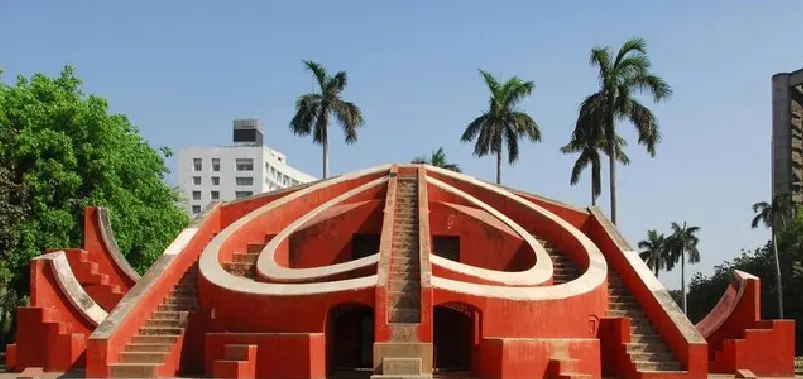
An impressive illustration of ancient Indian astronomy and scientific brilliance is Jantar Mantar. Constructed in the 18th century, this outdoor observatory draws tourists from all over the world who are interested in India's scientific and cultural contributions. For international tourists booking India private tours, luxury Golden Triangle tours, or custom India tours, Jantar Mantar offers an immersive blend of history, architecture, and curiosity.
It is a popular destination for international tourists who want to blend urban experiences with heritage exploration because of its convenient placement in Connaught Place. Regardless of your interests in history, architecture, or space exploration, Jantar Mantar is a must-see destination when visiting Delhi. For foreign visitors seeking more than just tourism, the observatory's combination of innovation, education, and cultural relevance is highly appealing.
The renowned astronomer and statesman Maharaja Jai Singh II of Jaipur constructed Jantar Mantar Delhi in 1724. His objective was to develop a collection of astronomical tools for better timekeeping and celestial body observation. In a time before contemporary telescopes, these mathematically precise tools were groundbreaking.
He built five observatories throughout India, including this one at Varanasi, Mathura, Ujjain, and Jaipur. One of the most popular tourist destinations nowadays is Delhi, which serves as a permanent reminder of India's contributions to the advancement of science worldwide. It demonstrates India's scientific prowess at a period when European astronomy was yet in its infancy.
Mantra (calculation) and Yantra (instrument) are Sanskrit words from which the name "Jantar Mantar" is derived. With startling accuracy, the stone and marble instruments were used to measure time, forecast eclipses, and monitor planetary movements. It is a living example of ancient astronomy as well as a historical monument.
Thirteen architectural astronomical instruments are housed in the observatory. The arrangement enables users to obtain real measurements with their unaided eyes, and each was designed for certain observations. The instruments' structural design inspires amazement and surprise in visitors by being both aesthetically pleasing and functional.
These instruments, when explained by an expert from an India tour guide and driver services, reveal India's advanced astronomical understanding centuries before modern equipment existed. For photography lovers, the clean geometric lines and red sandstone against blue skies make for dramatic visuals.
Location: Jantar Mantar Road, Connaught Place, New Delhi, Delhi 110001
Nearest Metro Stations: Patel Chowk (Yellow Line) and Rajiv Chowk (Blue/Yellow Line)
Being in the heart of Delhi, Jantar Mantar is easily accessible for tourists staying in central hotels or exploring Connaught Place. Those on India tour with private driver packages often pair this visit with nearby landmarks like India Gate, Janpath Market, and Gurudwara Bangla Sahib. Its central positioning makes it a strategic and efficient stop during half-day or Delhi same day tour programs.
Entry Timings and Ticket Fees
Opening Hours: Daily, 6:00 AM to 6:00 PM
Entry Fee:
Whether you’re on a long itinerary or a Delhi same day tour, Jantar Mantar fits neatly into morning or afternoon schedules, especially when you're traveling with the best travel agency in India. The well-regulated ticketing system and multilingual signage make it easy for international tourists to navigate.
Foreign travelers love visiting Jantar Mantar for its cultural and scientific intrigue. It’s a place where architecture, astrology, and history intersect—offering a unique experience unlike any other monument in Delhi.
Jantar Mantar is frequently included in:
Beyond sightseeing, Jantar Mantar inspires a deeper understanding of Indian intellect, making it an educational and experiential highlight in any itinerary. Its openness, simplicity, and beauty are often unexpected joys for travelers exploring India's capital.
Fill out this form with all the required information. Within 12 hours, we will provide you with a tailor-made itinerary at the best price.
Absolutely! It's a scientific and cultural marvel on many India private tours.
It was built in 1724 by Maharaja Jai Singh II.
Yes, through India tour guide and driver services.
Yes, often included in Golden Triangle Tours India.
Early morning or late afternoon for soft lighting and fewer crowds.
45 minutes to 1 hour is ideal.
Yes, photography is allowed.
Yes, it's educational and visually engaging.
No, but the Jaipur Jantar Mantar is.
Limited, so prefer India tour with private driver or metro.
Partially; some ramps are available.
Yes, Connaught Place offers many cafes and eateries.
Definitely; it's centrally located.
No, Jantar Mantar does not offer one.
They are functional and used for demonstrations.
Yes, popular among student groups and educational travelers.
English, Hindi, and more via India tour guide and driver services.
No, but nearby markets offer memorabilia.
Not officially, but tour agencies offer bundled packages.
The best travel agency in India, like Top Indian Holidays.
Experience authentic travel, request a custom quote today and get one step closer to your personalized trip.
Speak to our India Destination Experts at Call +91-8955000999